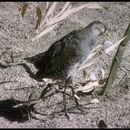mk
имиња во трошки


Observing a sora in its natural habitat is well worth the effort. Patient (and lucky) observers may catch a glimpse of this wetland inhabitant throughout the spring and early summer, at most any heavily vegetated wetland. Large, remote wetlands hosting dense stands of cattail (Typha latifolia) and other tall wetland plants often hold several pairs of breeding soras. Recorded playbacks (available at most birding stores) of soras or any other rail will virtually guarantee a response from a curious sora, although a whistled facsimile may also suffice (pers. obs.).
Perception Channels: visual ; tactile ; acoustic ; chemical
Numbers have declined across the sora's range, coinciding with loss of wetland habitat, however the species is still abundant (Kaufman, 1996). The sora is an unprotected species, and is considered to be a migratory game bird (U. S. Fish and Wildlife Service, 2000), although it is not often hunted.
US Migratory Bird Act: protected
US Federal List: no special status
CITES: no special status
State of Michigan List: no special status
IUCN Red List of Threatened Species: least concern
The sora is considered a game bird under the Migratory bird treaty act (U.S. Fish and Wildlife Service, 2000) and may be hunted for food.
Viewing a sora in its natural habitat is a well won prize for an avid birder's effort.
Diet consists mainly of seeds, insects and snails. Seeds are obtained from sedges (Carex spp.), grasses (Calamagrostis spp., Bromus spp., Scoacloa spp., Poa spp., etc) or other wetland plants. Snails and insects are picked from ground surface, or by probing soft mud and vegetation with its bill.
(Kaufman, 1996)
Breeding range:
The sora (Porzana carolina) occupies much of temperate North America, ranging (in the west) as far north as the Northwest Territories, to the southern extremes of Arizona and New Mexico. The breeding range of P. carolina narrows in the east, occurring from Canada's Maritime provinces south to Maryland, USA.
Overwintering range:
As wetlands freeze in the breeding range of P. carolina, this species moves south to overwinter, occupying the southern United States from Arizona to Florida, and also throughout Mexico. In addition, many individuals migrate across the Gulf of Mexico and Caribbean Sea to overwinter in South America.
The coastline of California hosts P. carolina year round.
(Kaufman, 1996)
Biogeographic Regions: nearctic (Native )
The sora occupies a freshwater wetland habitat throughout its range; it also uses salt marshes while overwintering. The preferred habitat provides considerable cover for breeding soras, and consists mostly of freshwater wetlands with stands of cattail, sedges, and other tall wetland plants (Kaufman, 1996).
Sexually monomorphic. Length 20-30 cm (8-10"). In its breeding plumage, the sora's throat and face are black, with a short, yellowish bill. The breast and nape of neck are gray. The back is mottled brown and the belly displays black and white barring.
Immature and non-breeding plumages are plainer and buff colored with no black on throat or face. While in this plumage, the throat is white and the breast is light brown. The legs of P. carolina are yellowish green. The tail is usually held erect while walking and flying.
(Godfrey, 1986; Semenchuk, 1992)
The body of a sora is suited for the marshy habitat that they occupy. Lateral compression of the body offers easy travel through dense vegetation. The sora possesses short, round wings which offer seemingly weak, but highly maneuverable flight through tangled vegetation. Strong legs, with long slender toes on provide P. carolina with a strong walking and running ability amongst tangled wetland vegetation. Although this species prefers walking to flying, its long distance capabilities are evident in its migration, often crossing the Gulf of Mexico and the Caribean.
(Semenchuk, 1992; Kaufman, 1996)
Other Physical Features: endothermic ; bilateral symmetry
Nests are woven into a shallow basket from dead emergent wetland vegetation, and attached to stalks of dense, live vegetation. Nests are generally placed over or adjacent to water, occasionally occurring in dry environments such as willows or grassy habitat near water's edge. (Godfrey, 1986).
The average clutch size ranges from 10-12 (sometimes 6-18) brown, spotted eggs, occasionally laid in two layers to accommodate such large numbers in a relatively small nest. Incubation by both parents lasts from 18-20 days, and is initiated with the laying of the first few eggs (Kaufman, 1996).
Young hatch asynchronously due to incremental stages of incubation. Precocial downy young may be cared for by one parent, as the other parent incubates remaining eggs. Young soras leave the nest shortly after hatching, and mainly forage themselves, having been taught by a parent (Salt and Salt, 1976). At 21-25 days young soras fledge and gain independence from their parents' care.
(Kaufman, 1996)
Key Reproductive Features: iteroparous ; gonochoric/gonochoristic/dioecious (sexes separate); sexual ; oviparous